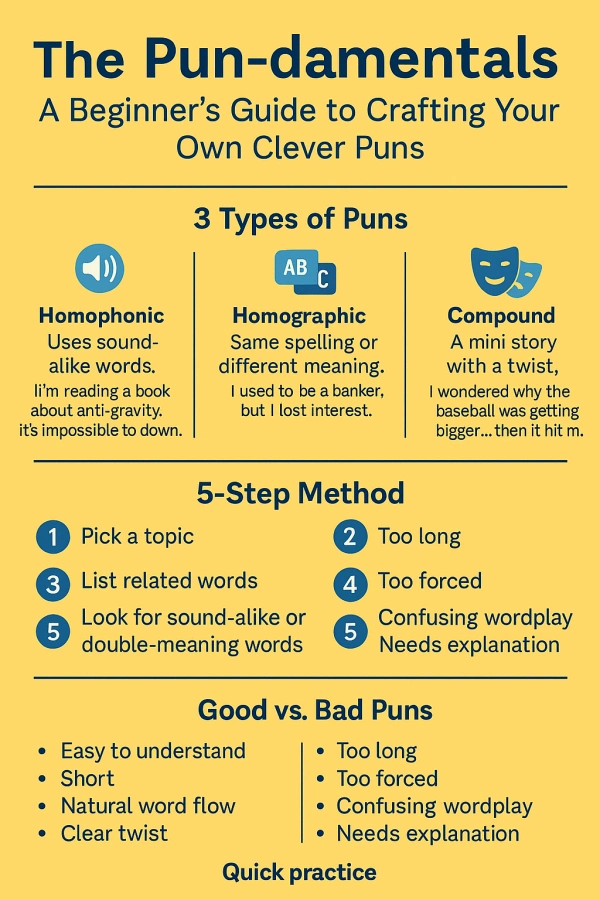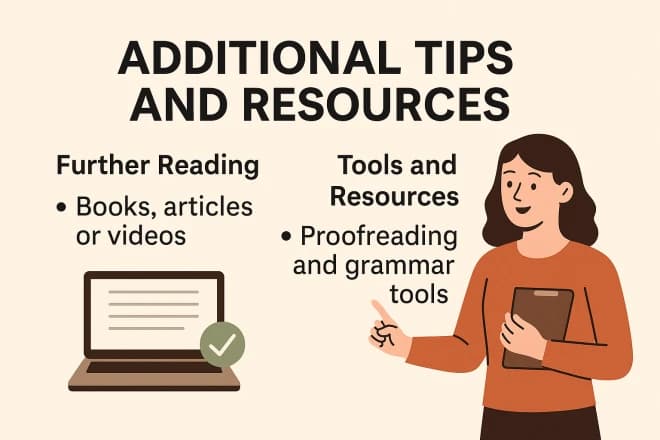Unlock Insights: Find the Answers You Seek on Our Blog
The Pun-damentals: A Beginner’s Guide to Crafting Clever Puns
By Evelyn Sterling
A pun is simply a sentence that plays with double meanings or similar sounds. It’s a small shift in language that creates a moment of surprise. Because of this, puns appear naturally in everyday life — captions, conversations, headlines, and even casual jokes between friends.
Many people assume you need to be “funny” to write a good pun, but that isn’t true. Pun-making has more to do with noticing patterns in words than being a comedian. Once you understand how puns are built, the process becomes approachable and even enjoyable.
To make things easier, the next section will break puns into three simple types. Knowing these basic categories gives you a clear starting point before you try writing your own.

🔍 The 3 Basic Types of Puns
Most puns follow one of three basic patterns. Understanding these patterns helps you see how puns work beneath the surface and makes the writing process more intuitive.
🔊 Homophonic Puns (sound-alike words)
Homophonic puns use two different words or phrases that sound similar. The sentence guides the reader toward one meaning before revealing another.
📌 Example:
“I’m reading a book about anti-gravity. It’s impossible to put down.”
The joke works because “impossible to put down” can describe both a compelling book and something affected by anti-gravity. The overlap creates a quick, clean twist.
🔤 Homographic Puns (same spelling, different meaning)
Homographic puns rely on a single word that holds more than one meaning. The humor comes from the shift in interpretation as the sentence reaches its end.
📌 Example:
“I used to be a banker, but I lost interest.”
“Interest” can refer to financial earnings or personal motivation. The line works because both meanings are plausible, and the switch happens in a single moment.
🎭 Compound Puns (a mini story with a twist)
Compound puns build a simple setup, then flip the meaning in the final phrase. This small delay creates a more noticeable twist.
📌 Example:
“I wondered why the baseball was getting bigger… then it hit me.”
The setup feels literal at first, but “then it hit me” shifts the meaning from a physical impact to sudden understanding. That shift is what makes the line land.
With these patterns in mind, the next section will outline a straightforward method you can use to create your own puns from scratch.
🛠️ A Simple 5-Step Method Anyone Can Follow
Writing a pun becomes much easier when you break the process into a few clear steps. This method is designed for everyday use — no special talent required, just a bit of curiosity about how words behave.
🧩 Step 1 — Pick a Topic
Start with something ordinary: coffee, cats, Mondays, the gym, sleep, travel — anything you encounter in daily life. A familiar topic gives you more language to work with and makes the pun feel natural rather than forced.
🗂️ Step 2 — List Related Words
Write down words, sayings, or small phrases people often use around that topic. They don’t need to be clever; they simply build the pool of language you’ll draw from. Sometimes the most basic words lead to the strongest puns.
🎧 Step 3 — Look for Sound-Alike or Double-Meaning Words
Scan your list for anything with more than one meaning or anything that sounds like another word. Homophones, near-homophones, and words with flexible interpretations are the most common building blocks of puns.
🔁 Step 4 — Create the Twist
Take one of those flexible words and shift its meaning in a small but surprising way. A simple example: the word “espresso” can sound like “express.” From there, you get a line like: “Don’t espresso your feelings.” The twist doesn’t need to be perfect — it just needs to change the expected meaning.
✂️ Step 5 — Keep It Short
Shorter puns feel cleaner and land more reliably. When the setup is brief, the twist has more room to stand out. If a pun starts to stretch, try cutting words until only the essential parts remain.
With this simple method, you can create small twists on everyday language without overthinking the process. In the next section, we’ll look at how to tell the difference between a strong pun and a weak one — and how to adjust your writing when something doesn’t quite land.
🎯 Good vs. Bad Puns (Simple and Honest)
Not every pun lands the same way. Some feel light and effortless; others feel heavy or confusing. Understanding the difference helps you refine your writing without becoming overly critical. The goal isn’t perfection — just clarity.
👍 What Makes a Good Pun
- Easy to understand
- Short and direct
- Natural word flow
- A clean, recognizable twist
📌 Good example:
“I’m on a seafood diet. I see food, and I eat it.”
The setup is simple, and the twist arrives immediately. The double meaning of “see food” is clear without needing extra explanation.
👎 What Makes a Weak Pun
- Too long or wordy
- Feels forced or unnatural
- Wordplay is unclear or hard to follow
- Needs explanation to be understood
📌 Weak example:
“I tried to write a joke about wind, but it blew me into thinking about air currents,
which was a breeze of inspiration — if you catch my drift.”
The idea is there, but the sentence is too long and tries to stack multiple wordplays at once. The twist gets lost, and the humor dilutes rather than sharpens.
Knowing these differences helps you adjust your own writing with less frustration. In the next section, we’ll walk through a quick practice exercise so you can try crafting a simple pun using the steps you’ve learned.
✏️ Quick Practice — Try One Right Now
The easiest way to get comfortable with puns is to try making one yourself. You don’t need the perfect idea — you just need a topic and a few minutes to play with words. This small exercise is meant to be simple and pressure-free.
✏️ Try this:
Make a pun about cats, pizza, or sleep using the five steps from the previous section.
Pick one topic, jot down a few related words, and look for anything with a double meaning or a similar sound. Don’t worry about being clever on the first try. Most puns start as rough ideas before they become clean, short twists.
Once you’ve created one, read it out loud. If the meaning shifts clearly and you can hear the twist, you’re on the right track. In the final section, we’ll offer a simple way to continue improving — and a tool you can use whenever you want quick inspiration.
Conclusion
If you ever find yourself stuck or want a few quick ideas to spark inspiration, you don’t have to wait for the perfect twist to arrive on its own. A little support can help you see new angles you might not notice right away.
When you need a starting point, try the AI Pun Generator. It gives you instant examples based on any topic you choose, so you can study the structure, refine your own ideas, or simply warm up before writing. Think of it as a helpful prompt, not a replacement for your creativity.
With a few patterns, a bit of practice, and the right tools when you need them, pun writing becomes less intimidating — and a lot more fun to explore.
AI Tools Categories
Browse all AI tools by category
All AI Tools
229Amazon
5AI Writing Generator
85Article & Content Writing
35Branding & Identity
54Content Generation
170Creative Ideas
32Educational Resources
34E-commerce
14Etsy
6Events & Celebrations
13Facebook
6Gaming & Fun
5Instagram
3Lifestyle & Personal
8LinkedIn
6Marketing & SEO
40Poem & Lyrics Writing
19Professional Documents
31Social Media
44Story & Book Writing
49Text Effects
14TikTok
7Twitter
3Writing Enhancement
36YouTube
11
Highly rated and most popular AI tools curated by our experts
Recently added AI tools that are gaining traction
- AI Post Generator

- AI Bullet Point Generator

- AI Discussion Post Generator

- AI 2 Weeks Notice Letter Generator

- AI Content Creation Ideas Generator

- AI Radio Ad Script Generator

- AI Podcast Script Generator

- AI Resume Objective Generator

- AI Resume Headline Generator

- AI Password Generator

- AI Snapchat Caption Generator

- AI Snapchat Username Generator

- AI Pinterest Board Name Generator

- AI LinkedIn Experience Description Generator

- AI Twitter Hashtag Generator

- AI YouTube Short Idea Generator

we prioritize displaying the latest content closely related to the current blog post.







